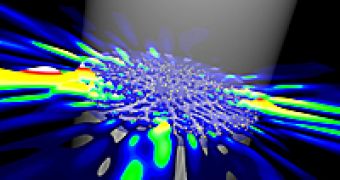Determining the properties of conventional lasers is relatively easy and can be done with the help of computer simulations, but when it comes to non-conventional lasers not even simulations can help determine the lasing mode and ultimately the properties of the laser. However it may be possible to predict them with a new theory developed at Yale University and the Institute of Quantum Electronics at ETH Zurich, which promises the unification of regular lasers with the diffusive random lasers.
"The lasers that most people are familiar with emit a narrow beam of light in a fixed direction that has a well-defined wavelength and a predictable power output - like those in laser pointers, bar-code readers, surgical instruments and CD players", said A. Douglas Stone, the Carl A. Morse Professor of Applied Physics at Yale.
Basically, a conventional laser generates light in a material and then amplifies it through a light amplification by stimulated emission of radiation. The emitted light particles bounce between two mirrors - one with 100 percent reflectiveness and another one with 99 percent reflectiveness - gathering energy and stimulating the material to emit even more light particles. When the photons have gathered sufficient energy, they penetrate through the mirror with 99 percent reflectiveness, to create a directional, monochromatic, coherent light emission called laser beam.
Now a new type of lasers is caching up, the diffusive random lasers (DRL), which have no mirrors but emit laser radiation from nanoparticles fabricated through modern technologies. The problem with DRLs is that currently there is no way to predict the wavelengths and the intensity of the light emission they generate, and although DRLs function on different principles, they have been found to share some similarities with all types of lasers.
In the case of conventional lasers, the properties are measured through lasing modes involving the light brightness patterns and wavelengths.
"For random lasers, time-dependent simulations are difficult to do, hard to interpret, and don't answer the question: 'What is the nature of the lasing modes in a random laser.' Researchers really wanted a description similar to that for conventional lasers, but no one knew how to develop such a description", Stone wrote.
The non-linear equations of the unification theory have to fit conventional lasers as well as DRLs, and have been used by Stone and Hakan E. Tureci, a former PhD student of him now at ETH Zurich, along with Li Ge and Stefan Rotter to create a model able to predict the properties of lasers based on a series of simple parameters.
"The state of laser theory after forty years was an embarrassment; it was essentially qualitative, but not predictive or quantitative. We went back to the basics - and we think we have now solved that problem. Ultimately, we hope that our code can be used as a design tool for new classes of micro- and nano-lasers with important applications", concluded Stone.

 14 DAY TRIAL //
14 DAY TRIAL //